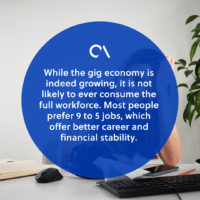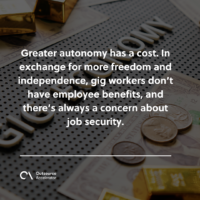Reid Hoffman’s prediction
LinkedIn co-founder Reid Hoffman’s claim that the 9 to 5 job will be extinct in 2034 is a gross misinterpretation of how the workplace will look in the near future. Possibly the tech scion is a little out of touch…
He predicts that most workers will leave their full-time jobs and enter the gig economy, where they’ll work two to three gigs at a time. Hoffman envisions a workforce transformation driven by the gig economy and advancements in artificial intelligence.
While the gig economy is indeed growing, it is not likely to ever consume the full workforce. Most people prefer 9 to 5 jobs, which offer better career and financial stability. It seems that Hoffman’s prediction doesn’t align with what a regular employee is and wants.
Stable employment and fair pay
Only a handful of people dedicate 100% of their lives to a profession. For most people, work and life are two separate things. A regular employee’s priorities might be family, sports, religion, or something else. A job with a consistent compensation package allows them to pay the bills and afford a lifestyle.
The 9 to 5 schedule empowers them to have a separate life outside of work. Most workers are eager to log off once the clock hits five so they can enjoy their pay after a hard day’s work. On the weekends, they are free to do leisure activities, pursue hobbies, and spend time with the kids without being bothered by their bosses. Generally speaking, people love the stability and predictability of a 9 to 5 job.
In short, 9 to 5 is far from perfect, but it is the best worst option so far.
The costs of a gig worker
Meanwhile, gig workers have better flexibility than their 9 to 5 counterparts. Each day may look different depending on the gig professional’s liking. As Hoffman noted, these workers can take on several clients at any given time and have more control over their monthly earnings. This means that gig workers may sometimes work for just a few hours on a certain day, but on some days, they work over eight hours and during weekends.
Greater autonomy has a cost. In exchange for more freedom and independence, gig workers don’t have employee benefits, and there’s always a concern about job security. They also manage their own taxes, which is considered a major hassle by an ordinary worker. There are some upsides to gig work, but there are also many downsides. It’s a work style that does not fit everyone’s tastes.
The question for your business
What will your workplace look like in 10 years?




 Independent
Independent





















